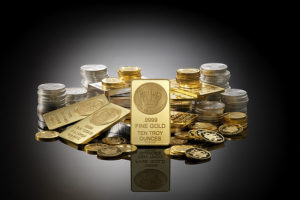Traders get bullish on gold when the economy tanks as it is then that the price of the shiny yellow metal appreciates. In light of the economic problems that have plagued the global economy in recent years, gold is at an all-time high of $1770 per ounce.
Trading gold futures is no easy task as futures contracts always come with the risk of losing a lot of money. With this risk come rich rewards for sophisticated investors. Buyers in a futures contract feel that gold will increase in price as opposed to sellers who are betting on potential declines.
The foremost reason why people hold gold is because it serves as an inflation hedge and it is also a form of alternative currency. I will focus on the U.S. economy measures that affect the gold price in this article.
The price of the precious metal goes up when uncertainty is rampant and there is poor economic growth. The 2008 financial crisis illustrated this clearly with gold hitting $1000 an ounce for the first time ever.
Inflation is gold’s best friend and so is the dollar when it falls. Another factor is consumer confidence that impacts gold futures. In the last month, consumer confidence has dropped, and the gold price has climbed once again.
The Fed’s recent QE3 which costs $2 trillion has made investors even more bullish about gold. Falling interest rates will see higher demand for gold too with bonds being less attractive investments. For this reason many of the leading thinkers on Wall Street have been ditching their more traditional habits and have instead been opting to trade in gold. In fact there was a recent article in the Wall Street Journal that highlighted just this trend.
Housing data is another U.S. economy measure to take note of. House prices across 20 U.S. cities have increased a little bit according to the Standard & Poor’s/Case Shiller House Price index. As a result, the precious metal’s price has declined as of late which is not in keeping with its long-term uptrend.
There is a historical correlation between stock market performance and the gold price which is negative. A bull market sees gold lose its value, whereas a bear market has been helpful in skyrocketing the price of gold. It could be argued that the very same factors that cause a bear market – poor housing data, increasing inflation, falling consumer confidence – raise the demand for gold.
It has happened one too many times in history. The Dow Jones Industrial Average bottomed out in 1973 and there was a concurrent increase in the gold price from $65 per ounce to $195 per ounce. Furthermore, the bear market in October 1987 saw the price of gold reach its then all-time high of $500 an ounce. The 2008 financial crisis serves as another example.
The price of crude oil has a historical correlation with the gold price too. But this is positive! The reason is probably because an increase in oil revenues due to higher oil prices will be invested in gold.
The price of gold is rising and rising and it should continue to do so. Concerns about the economy persist and central banks continue to hoard gold and buttress the financial markets via quantitative easing.



